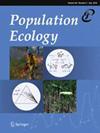选择性采伐对楔石槲寄生遗传多样性和种群结构的影响
IF 1
4区 环境科学与生态学
Q4 ECOLOGY
引用次数: 0
摘要
生境退化的影响尚未得到充分认识。最近的一项研究表明,生境退化对植物遗传多样性的影响较小,但生境质量的降低可能通过生态相互作用间接影响植物遗传多样性和基因流动。选择性采伐是生境退化的一种方式,但其对非采伐森林植物物种遗传多样性影响的研究相对较少。利用3470个单核苷酸多态性,我们评估了不同选择采伐强度对66个梯形槲寄生(Tristerix corymbosus)遗传多样性的影响。我们还研究了在智利南部温带雨林的三个地点,在不同程度的选择性砍伐强度下,其种子传播者(Dromiciops gliroides)丰度的可能关系。结果表明,选择性采伐增加了该槲寄生的等位基因丰富度和近交;近交随选择采伐强度的增加而增加,杂合度随选择采伐强度的增加而降低。虽然木材提取似乎积极地影响了松木的遗传多样性,但其长期后果,如增加近亲繁殖,还有待于在未来的研究中评估。本文章由计算机程序翻译,如有差异,请以英文原文为准。
Effects of selective logging on genetic diversity and population structure of a keystone mistletoe
Abstract The effects of habitat degradation remain not fully understood. A recent study reported low effects of habitat degradation on plant genetic diversity but indicates that reduction in habitat quality could impact it as well as gene flow indirectly via ecological interactions. Selective logging is a way of habitat degradation, but studies examining its effects on plant genetic diversity on non‐logged forest plant species are relatively scarce. Using 3470 single‐nucleotide polymorphisms, we assess the effects of different selective logging intensities on the genetic diversity of 66 individuals of a keystone mistletoe ( Tristerix corymbosus ). We also examined the possible relationship with its seed disperser ( Dromiciops gliroides ) abundance in three sites of the temperate rainforests of southern Chile, with different levels of selective logging intensity. Our results show that selective logging increases allelic richness and inbreeding in this mistletoe; inbreeding increased with selective logging intensity, and heterozygosity decreased with D. gliroides abundance. While wood extraction seems to positively affect T. corymbosus genetic diversity, its long‐term consequences—such as increased inbreeding—are yet to be assessed in future studies.
求助全文
通过发布文献求助,成功后即可免费获取论文全文。
去求助
来源期刊

Population Ecology
环境科学-生态学
CiteScore
3.90
自引率
11.80%
发文量
41
审稿时长
18-36 weeks
期刊介绍:
Population Ecology, formerly known as Researches on Population Ecology launched in Dec 1952, is the official journal of the Society of Population Ecology. Population Ecology publishes original research articles and reviews (including invited reviews) on various aspects of population ecology, from the individual to the community level. Among the specific fields included are population dynamics and distribution, evolutionary ecology, ecological genetics, theoretical models, conservation biology, agroecosystem studies, and bioresource management. Manuscripts should contain new results of empirical and/or theoretical investigations concerning facts, patterns, processes, mechanisms or concepts of population ecology; those purely descriptive in nature are not suitable for this journal. All manuscripts are reviewed anonymously by two or more referees, and the final editorial decision is made by the Chief Editor or an Associate Editor based on the referees'' evaluations.
 求助内容:
求助内容: 应助结果提醒方式:
应助结果提醒方式:


